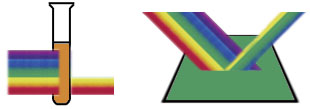Spectroscopy - Seeing Colors
Why We See Colors
The different wavelengths within the visible region are responsible for the different colors we see. The acronym "ROYGBIV" helps us to remember the colors of red, orange, yellow, green, blue, indigo and violet. Note that these are in reverse order on the figure below. Violet is the most energetic color and red is the least.

According to the figure, if someone shined light with a wavelength of 550 nm at us it would look green.
If someone shined white light at us, what wavelength does it have? White is not in our visible spectrum because it is composed of all the wavelengths of light. A light bulb is a good example. It looks white because it is emitting at least some of all the wavelengths in the visible region. Objects like this are called blackbody radiators.
Colored liquids or solutions look colored because they absorb some of the light shined on them. The test tube in the figure contains an orange solution. The solar spectra is white light. When sunlight shines through an orange solution, the violet, blue and green wavelengths are absorbed. The other colors pass through. The transmitted light is the light we see, and it looks orange.

Colored objects look the way they do because of reflected light. When sunlight is shined on a green leaf, the violet, red and orange wavelengths are absorbed. The reflected wavelengths appear green.
In each case we are seeing the complementary colors to the ones absorbed.
By looking at the absorption spectrum and complementary colors for chlorophyll we should be able to predict that plants look green.
Black and white objects are just the extremes of colored objects. Black objects absorb all the light shined on them. There is no reflected light, so we see black (the absence of color). If all of the light is reflected, we see all the wavelengths, which means we see white light.
Continue to read about how light interacts with atoms.






